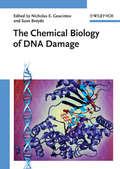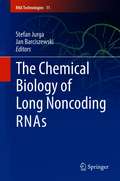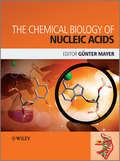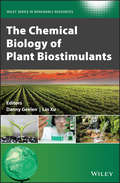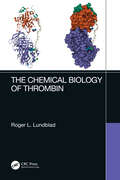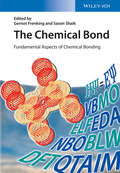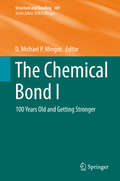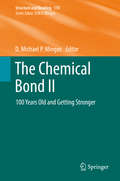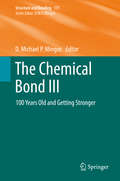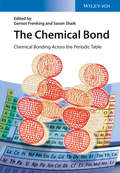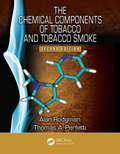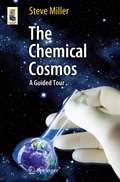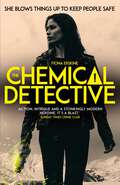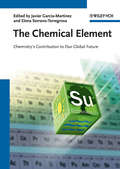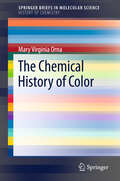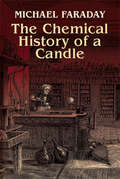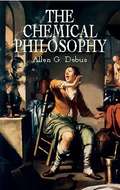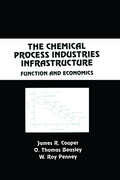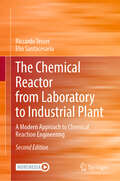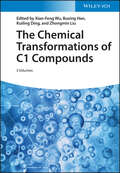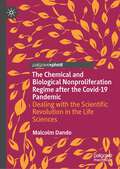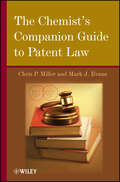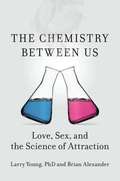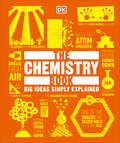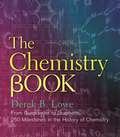- Table View
- List View
The Chemical Biology of DNA Damage
by Nicholas E. Geacintov Suse BroydeBringing the power of biochemical analysis to toxicology, this modern reference explains genotoxicity at the molecular level, showing the links between a DNA lesion and the resulting cellular or organismic response. Clearly divided into two main sections, Part 1 focuses on selected examples of important DNA lesions and their biological impact, while the second part covers current advances in assessing and predicting the genotoxic effects of chemicals, taking into account the biological responses mediated by the DNA repair, replication and transcription machineries. A ready reference for biochemists, toxicologists, molecular and cell biologists, and geneticists seeking a better understanding of the impact of chemicals on human health.
The Chemical Biology of Long Noncoding RNAs (RNA Technologies #11)
by Jan Barciszewski Stefan JurgaThis book offers a comprehensive and detailed overview of various aspects of long non-coding RNAs. It discusses their emerging significance in molecular medicine, ranging from human cancers to cardiovascular and metabolic diseases. Transcriptomic studies have demonstrated that the majority of genomes found in complex organisms are expressed in highly dynamic and cell-specific patterns, producing huge numbers of intergenic, antisense and intronic long non-protein-coding RNAs (lncRNAs). Thousands of lncRNAs have been identified, and unlike mRNA, they have no protein-coding capacity. A large repertoire of ncRNAs, actively transcribed from the mammalian genome, control diverse cellular processes, both in terms of development and diseases, through a variety of gene regulatory mechanisms. IncRNAs have emerged as a new paradigm in epigenetic regulation of the genome. Given its scope, the book will be of particular interest to molecular, chemical, cell and developmental biologists, as well as specialists in translational medicine involved in disease-oriented research. It also offers a valuable resource for in silico experts seeking a deeper understanding of lncRNA expression and function through computational analysis of the NGS data.
The Chemical Biology of Nucleic Acids
by Günter MayerWith extensive coverage of synthesis techniques and applications, this text describes chemical biology techniques which have gained significant impetus during the last five years. It focuses on the methods for obtaining modified and native nucleic acids, and their biological applications. Topics covered include: chemical synthesis of modified RNAexpansion of the genetic alphabet in nucleic acids by creating new base pairschemical biology of DNA replication: probing DNA polymerase selectivity mechanisms with modified nucleotidesnucleic-acid-templated chemistrychemical biology of peptide nucleic acids (PNA)the interactions of small molecules with DNA and RNAthe architectural modules of folded RNAsgenesis and biological applications of locked nucleic acid (LNA)small non-coding RNA in bacteriamicroRNA-guided gene silencingnucleic acids based therapiesinnate immune recognition of nucleic acidlight-responsive nucleic acids for the spatiotemporal control of biological processesDNA methylationframeworks for programming RNA devicesRNA as a catalyst: The Diels-Alderase-Ribozymeevolving an understanding of RNA function by in vitro approachesthe chemical biology of aptamers: synthesis and applicationsnucleic acids as detection toolsbacterial riboswitch discovery and analysisThe Chemical Biology of Nucleic Acids is an essential compendium of the synthesis of nucleic acids and their biological applications for bioorganic chemists, chemical biologists, medicinal chemists, cell biologists, and molecular biologists.
The Chemical Biology of Plant Biostimulants (Wiley Series in Renewable Resource)
by Christian V. StevensIntroduces readers to the chemical biology of plant biostimulants This book brings together different aspects of biostimulants, providing an overview of the variety of materials exploited as biostimulants, their biological activity, and agricultural applications. As different groups of biostimulants display different bioactivity and specificity, advances in biostimulant research is illustrated by different examples of biostimulants, such as humic substance, seaweed extracts, and substances with hormone-like activities. The book also reports on methods used to screen for new biostimulant compounds by exploring natural sources. Combining the expertise of internationally-renowned scientists and entrepreneurs in the area of biostimulants and biofertilisers, The Chemical Biology of Plant Biostimulants offers in-depth chapters that look at: agricultural functions and action mechanisms of plant biostimulants (PBs); plant biostimulants from seaweed; seaweed carbohydrates; and the possible role for electron shuttling capacity in elicitation of PB activity of humic substances on plant growth enhancement. The subject of auxins is covered next, followed closely by a chapter on plant biostimulants in vermicomposts. Other topics include: exploring natural resources for biostimulants; the impact of biostimulants on whole plant and cellular levels; the impact of PBs on molecular level; and the use of use of plant metabolites to mitigate stress effects in crops. Provides an insightful introduction to the subject of biostimulants Discusses biostimulant modes of actions Covers microbial biostimulatory activities and biostimulant application strategies Offers unique and varied perspectives on the subject by a team of international contributors Features summaries of publications on biostimulants and biostimulant activity The Chemical Biology of Plant Biostimulants will appeal to a wide range of readers, including scientists and agricultural practitioners looking for more knowledge about the development and application of biostimulants.
The Chemical Biology of Thrombin
by Roger L. LundbladThis book is a comprehensive review of thrombin, especially as regulatory protease. The ready availability of highly purified thrombin has stimulated rapid advances in the cell biology of this important macromolecule. The text focuses on research findings from the discovery of thrombin by Andrew Buchanan in 1842 to the present. A substantial amount of this work was conducted by the author and his colleagues. His work on the purification of thrombin was seminal to much subsequent work on thrombin. This volume provides a framework for future studies now made possible by the discovery of the importance of exosites in the physiology of thrombin function. The current work describes the process of the development of an oral inhibitor of thrombin used in the prevention of thrombosis. Key Features Reviews the history of Thrombin (Fibrin Ferment) Documents the relation of protein engineering and chemical modification in the study of thrombin Summarizes the interaction of thrombin with fibrinogen and fibrin Outlines the role of exosites in thrombin function Describes the development of an oral inhibitor for thrombin
The Chemical Bond - Fundamental Aspects of Chemical Bonding
by Sason Shaik Gernot FrenkingThis is the perfect complement to "Chemical Bonding - Across the Periodic Table" by the same editors, who are two of the top scientists working on this topic, each with extensive experience and important connections within the community.The resulting book is a unique overview of the different approaches used for describing a chemical bond, including molecular-orbital based, valence-bond based, ELF, AIM and density-functional based methods. It takes into account the many developments that have taken place in the field over the past few decades due to the rapid advances in quantum chemical models and faster computers.
The Chemical Bond I
by D. Michael P. MingosThe series Structure and Bonding publishes critical reviews on topics of research concerned with chemical structure and bonding. The scope of the series spans the entire Periodic Table and addresses structure and bonding issues associated with all of the elements. It also focuses attention on new and developing areas of modern structural and theoretical chemistry such as nanostructures, molecular electronics, designed molecular solids, surfaces, metal clusters and supramolecular structures. Physical and spectroscopic techniques used to determine, examine and model structures fall within the purview of Structure and Bonding to the extent that the focus is on the scientific results obtained and not on specialist information concerning the techniques themselves. Issues associated with the development of bonding models and generalizations that illuminate the reactivity pathways and rates of chemical processes are also relevant. The individual volumes in the series are thematic. The goal of each volume is to give the reader, whether at a university or in industry, a comprehensive overview of an area where new insights are emerging that are of interest to a larger scientific audience. Thus each review within the volume critically surveys one aspect of that topic and places it within the context of the volume as a whole. The most significant developments of the last 5 to 10 years should be presented using selected examples to illustrate the principles discussed. A description of the physical basis of the experimental techniques that have been used to provide the primary data may also be appropriate, if it has not been covered in detail elsewhere. The coverage need not be exhaustive in data, but should rather be conceptual, concentrating on the new principles being developed that will allow the reader, who is not a specialist in the area covered, to understand the data presented. Discussion of possible future research directions in the area is welcomed. Review articles for the individual volumes are invited by the volume editors
The Chemical Bond II
by D. Michael P. MingosThe series Structure and Bonding publishes critical reviews on topics of research concerned with chemical structure and bonding. The scope of the series spans the entire Periodic Table and addresses structure and bonding issues associated with all of the elements. It also focuses attention on new and developing areas of modern structural and theoretical chemistry such as nanostructures, molecular electronics, designed molecular solids, surfaces, metal clusters and supramolecular structures. Physical and spectroscopic techniques used to determine, examine and model structures fall within the purview of Structure and Bonding to the extent that the focus is on the scientific results obtained and not on specialist information concerning the techniques themselves. Issues associated with the development of bonding models and generalizations that illuminate the reactivity pathways and rates of chemical processes are also relevant. The individual volumes in the series are thematic. The goal of each volume is to give the reader, whether at a university or in industry, a comprehensive overview of an area where new insights are emerging that are of interest to a larger scientific audience. Thus each review within the volume critically surveys one aspect of that topic and places it within the context of the volume as a whole. The most significant developments of the last 5 to 10 years should be presented using selected examples to illustrate the principles discussed. A description of the physical basis of the experimental techniques that have been used to provide the primary data may also be appropriate, if it has not been covered in detail elsewhere. The coverage need not be exhaustive in data, but should rather be conceptual, concentrating on the new principles being developed that will allow the reader, who is not a specialist in the area covered, to understand the data presented. Discussion of possible future research directions in the area is welcomed. Review articles for the individual volumes are invited by the volume editors
The Chemical Bond III
by D. Michael P. MingosThe series Structure and Bonding publishes critical reviews on topics of research concerned with chemical structure and bonding. The scope of the series spans the entire Periodic Table and addresses structure and bonding issues associated with all of the elements. It also focuses attention on new and developing areas of modern structural and theoretical chemistry such as nanostructures, molecular electronics, designed molecular solids, surfaces, metal clusters and supramolecular structures. Physical and spectroscopic techniques used to determine, examine and model structures fall within the purview of Structure and Bonding to the extent that the focus is on the scientific results obtained and not on specialist information concerning the techniques themselves. Issues associated with the development of bonding models and generalizations that illuminate the reactivity pathways and rates of chemical processes are also relevant. The individual volumes in the series are thematic. The goal of each volume is to give the reader, whether at a university or in industry, a comprehensive overview of an area where new insights are emerging that are of interest to a larger scientific audience. Thus each review within the volume critically surveys one aspect of that topic and places it within the context of the volume as a whole. The most significant developments of the last 5 to 10 years should be presented using selected examples to illustrate the principles discussed. A description of the physical basis of the experimental techniques that have been used to provide the primary data may also be appropriate, if it has not been covered in detail elsewhere. The coverage need not be exhaustive in data, but should rather be conceptual, concentrating on the new principles being developed that will allow the reader, who is not a specialist in the area covered, to understand the data presented. Discussion of possible future research directions in the area is welcomed. Review articles for the individual volumes are invited by the volume editors
The Chemical Bond: Chemical Bonding Across the Periodic Table
by Sason Shaik Gernot FrenkingA unique overview of the different kinds of chemical bonds that can be found in the periodic table, from the main-group elements to transition elements, lanthanides and actinides. It takes into account the many developments that have taken place in the field over the past few decades due to the rapid advances in quantum chemical models and faster computers. This is the perfect complement to "Chemical Bonding - Fundamentals and Models" by the same editors, who are two of the top scientists working on this topic, each with extensive experience and important connections within the community.
The Chemical Components of Tobacco and Tobacco Smoke
by Alan Rodgman Thomas A. PerfettiAuthored by two longtime researchers in tobacco science, The Chemical Components of Tobacco and Tobacco Smoke, Second Edition chronicles the progress made from late 2008 through 2011 by scientists in the field of tobacco science. The book examines the isolation and characterization of each component. It explores developments in pertinent analytical
The Chemical Cosmos
by Steve MillerIf you have ever wondered how we get from the awesome impersonality of the Big Bang universe to the point where living creatures can start to form, and evolve into beings like you, your friends and your family, wonder no more. Steve Miller provides us with a tour through the chemical evolution of the universe, from the formation of the first molecules all the way to the chemicals required for life to evolve. Using a simple Hydrogen molecule - known as H-three-plus - as a guide, he takes us on a journey that starts with the birth of the first stars, and how, in dying, they pour their hearts out into enriching the universe in which we live. Our molecular guide makes its first appearance at the source of the Chemical Cosmos, at a time when only three elements and a total of 11 molecules existed. From those simple beginnings, H-three-plus guides us down river on the violent currents of exploding stars, through the streams of the Interstellar Medium, and into the delta where new stars and planets form. We are finally left on the shores of the sea of life. Along the way, we meet the key characters who have shaped our understanding of the chemistry of the universe, such as Cambridge physicist J.J. Thomson and the Chicago chemist Takeshi Oka. And we are given an insider's view of just how astronomers, making use of telescopes and Earth-orbiting satellites, have put together our modern view of the Chemical Cosmos.
The Chemical Detective
by Fiona ErskineFor fans of Killing Eve and Orphan X comes the electrifying Chemical Detective Dr Jaq Silver. Skier, scientist, international jet-setter, explosives expert. She blows things up to keep people safe. Working on avalanche control in Slovenia, Jaq stumbles across a problem with a consignment of explosives. After raising a complaint with the supplier, a multinational chemical company, her evidence disappears. Jaq is warned, threatened and suspended. When she takes her complaint further, she narrowly escapes death only to be framed for murder. Escaping from police custody, she sets out to find the key to the mystery. Racing between the snowy slopes of Slovenia and the ghostly ruins of Chernobyl, can she uncover the truth before her time runs out?
The Chemical Element: Chemistry's Contribution to Our Global Future
by Javier Garcia-Martinez Elena Serrano-TorregrosaIn the International Year of Chemistry, prominent scientists highlight the major advances in the fight against the largest problems faced by humanity from the point of view of chemistry, showing how their science is essential to ensuring our long-term survival. Following the UN Millennium Development Goals, the authors examine the ten most critical areas, including energy, climate, food, water and health. All of them are opinion leaders in their fields, or high-ranking decision makers in national and international institutions. Intended to provide an intellectual basis for the future development of chemistry, this book is aimed at a wide readership including students, professionals, engineers, scientists, environmentalists and anyone interested in a more sustainable future.
The Chemical History of Color
by Mary Virginia OrnaIn this brief, Mary Virginia Orna details the history of color from the chemical point of view. Beginning with the first recorded uses of color and ending in the development of our modern chemical industry, this rich, yet concise exposition shows us how color pervades every aspect of our lives. Our consciousness, our perceptions, our useful appliances and tools, our playthings, our entertainment, our health, and our diagnostic apparatus - all involve color and are based in no small part on chemistry.
The Chemical History of a Candle
by Michael FaradayOne of the greatest experimental scientists of all time, Michael Faraday (1791–1867) developed the first electric motor, electric generator, and dynamo — essentially creating the science of electrochemistry. This book, the result of six lectures he delivered to young students at London’s Royal Institution, concerns another form of energy — candlelight.Faraday titled the lectures "The Chemical History of a Candle," choosing the subject because, as he explained, "There is not a law under which any part of this universe is governed which does not come into play and is not touched upon [during the time a candle burns]."That statement is the foundation for a book that describes, with great clarity, the components, function and weight of the atmosphere; the function of a candle wick; capillary attraction; the carbon content in oxygen and living bodies; the production of carbon dioxide from coal gas and sugar; the properties of carbonic acid; respiration and its analogy to the burning of a candle; and much more. There is also a chapter comprising Faraday's "Lecture on Platinum."A useful classroom teaching tool, this classic text will also appeal to a wide audience interested in scientific inquiry.
The Chemical Philosophy (Dover Books on Chemistry)
by Allen G. DebusSwiss-born physician and alchemist Paracelsus (1493-1541) and his disciples espoused a doctrine they proclaimed as a truly Christian interpretation of nature in chemistry. Drawing upon a mixture of ancient, medieval, and Renaissance sources, they developed a new philosophy that interpreted both macrocosmic and microcosmic events through the personal observations of the chemist and the Divine Grace of the Lord. Until the publication of this book, however, the breadth and vicissitudes of the Paracelsian approach to nature and medicine had been little studied. This volume spans more than a century, providing a rich record of the major interests of the Paracelsian and other chemical philosophers and the conflicts in which they engaged with their contemporaries. It examines chemistry and nature in the Renaissance, the Paracelsian debates, the theories of Robert Fludd, the Helmontian restatement of the chemical philosophy, and many other issues of this transitional era in the history of science. Enhanced with 36 black-and-white illustrations, this well-researched and compellingly related study will fascinate students of the history of science, chemistry, and medicine.
The Chemical Process Industries Infrastructure: Function and Economics (Chemical Industries)
by Lames R. Couper O. Thomas Beasley W. Roy Penney"Covers global and domestic competition, marketing strategies, operating expenses, and environmental and safety regulations for chemical professionals at all levels. Contains up-to-date mergers and acquisitions of chemical companies."
The Chemical Reactor from Laboratory to Industrial Plant: A Modern Approach to Chemical Reaction Engineering
by Elio Santacesaria Riccardo TesserThis second edition presents updated key concepts and exercises in chemical reaction engineering. While retaining the foundational structure of the first edition, this graduate textbook offers 2 new chapters devoted to polymerization reactions and reactors, and to bioreactors, and provides a complete and more suitable overview of the field for students and researchers of Chemical Reaction Engineering Sciences. The Preface of this edition has been rewritten to justify the changes conducted since the first edition. The subsequent chapters introduce students to the concepts behind the successful design and operation of chemical reactors, with an emphasis on qualitative arguments, simple design methods, graphical procedures, and frequent comparison of capabilities of the major reactor types. These chapters were updated and/or enriched with new exercises, and particular attention was given to the following topics: Chapter 2: Expanded Vapour-Liquid Equilibria (VLE) in multi-component systems with new exercises, including flash separation with reaction. Chapter 3: Deepened surface acidity distribution of heterogeneous catalysts with a new exercise. Chapters 4 & 5: Enlarged exercises with further calculations, plots, and new solved exercises. Chapter 6: Enriched with a new exercise on effectiveness factor calculation, covering mass, heat, and momentum transport laws and their relationship with chemical kinetics. Chapter 7: Added exercise to determine concentration profiles in the liquid film for gas-liquid reactions at different reaction rates. Chapter 8: New chapter on polymers and polymerization reactors, detailing mechanisms and kinetics with solved examples and exercises for various polymerization types. Chapter 9: New chapter on Bioreactors, covering the evolution of kinetic models for fermentation processes, including metabolic and cybernetic models applied to baker yeast and bioethanol production, with examples and solved exercises. The authors conducted a comprehensive revision of all the MATLAB code exercises to ensure they aligned with current learning objectives and described in detail the mathematical strategy adopted, particularly for the more complex problems. With expanded content, practical exercises, and new chapters, this textbook equips students and professionals alike with the knowledge and tools to excel in chemical and industrial engineering.
The Chemical Transformations of C1 Compounds
by Xiao-Feng Wu Kuiling Ding Buxing Han Zhongmin LiuThe Chemical Transformations of C1 Compounds A comprehensive exploration of one-carbon molecule transformations The chemistry of one-carbon molecules has recently gained significant prominence as the world transitions away from a petroleum-based economy to a more sustainable one. In The Chemical Transformations of C1 Compounds, an accomplished team of chemists delivers an in-depth overview of recent developments in the field of single-carbon chemistry. The three-volume book covers all major C1 sources, including carbon monoxide, carbon dioxide, methane, methanol, formic acid, formaldehyde, carbenes, C1 halides, and organometallics. The editors have included resources discussing the main reactions and transformations into feedstock chemicals of each of the major C1 compounds reviewed in dedicated chapters. Readers will discover cutting-edge material on organic transformations with MeNO2, DMF, DCM, methyl organometallic reagents, CCl4, CHCl3, and CHBr3, as well as recent achievements in cyanation reactions via cross-coupling. The book also offers: Thorough introductions to chemical transformations of CH4, methods of CH4 activation, chemical transformations of CH3OH and synthesis alkenes from CH3OH Comprehensive explorations of the carbonylation of MeOH, CH2O in organic synthesis, organic transformations of HCO2H, and hydrogen generation from HCO2H Practical discussions of the carbonylation of unsaturated bonds with heterogeneous and homogeneous catalysts, as well as the carbonylation of C(sp2)-X bonds and C(sp3)-X bonds In-depth examinations of carbonylative C-H bond activation and radical carbonylation Perfect for organic and catalytic chemists, The Chemical Transformations of C1 Compounds is also an ideal resource for industrial chemists, chemical engineers, and practitioners at energy supply companies.
The Chemical and Biological Nonproliferation Regime after the Covid-19 Pandemic: Dealing with the Scientific Revolution in the Life Sciences
by Malcolm DandoThis book offers an analysis of how the Chemical and Biological Weapons (CBW) regime has responded in the immediate aftermath of the Covid-19 pandemic. Coronavirus has highlighted the need to better protect modern societies from natural, accidental and deliberate disease affecting humans, animals and plants. Within that context preventing the deliberate hostile use of biological and chemical agents will be of increasing importance. Dando asks to what extent there has been a significant strengthening to the CBW non-proliferation regime in the immediate aftermath of the COVID-19 pandemic using an analysis focused on two proposals to strengthen the Chemical Weapons Convention and the Biological and Toxin Weapons Convention which aim to constrain advances in science and technology developments that could be misused. On this basis he concludes that it would be hard to argue that to date there has been a significant strengthening of the CBW regime.
The Chemist's Companion Guide to Patent Law
by Chris P. Miller Mark J. EvansWritten by an individual with experience as both a chemist and a patent attorney, The Chemist's Companion Guide to Patent Law covers everything the student or working chemist needs to know about patentability, explaining important concepts of patent law (such as novelty, non-obviousness, and freedom-to-operate) in easy-to-understand terms. Through abundant examples from case law as well as real-world situations with which a researcher might be faced, this book provides readers with a better understanding of how to put that knowledge into practice.
The Chemistry Between Us
by Brian Alexander Larry YoungHow much control do we have over love? Much less than we like to think. All that mystery, all that poetry, all those complex behaviors surrounding human bonding leading to the most life-changing decisions we'll ever make, are unconsciously driven by a few molecules in our brains. How does love begin? How can two strangers come to the conclusion that it would not only be pleasant to share their lives, but that they must share them? How can a man say he loves his wife, yet still cheat on her? Why do others stay in relationships even after the romance fades? How is it possible to fall in love with the "wrong" person? How do people come to have a "type"? Physical attraction, jealousy, infidelity, mother-infant bonding--all the behaviors that so often leave us befuddled--are now being teased out of the fog of mystery thanks to today's social neuroscience. Larry Young, one of the world's leading experts in the field, and journalist Brian Alexander explain how those findings apply to you. Drawing on real human stories and research from labs around the world, The Chemistry Between Us is a bold attempt to create a "grand unified theory" of love. Some of the mind-blowing insights include: Love can get such a grip on us because it is, literally, an addiction. To a woman falling in love, a man is like her baby. Why it's false to say society makes gender, and how it's possible to have the body of one gender and the brain of another. Why some people are more likely to cheat than others. Why we sometimes truly can't resist temptation. Young and Alexander place their revelations into historical, political, and social contexts. In the process, they touch on everything from gay marriage to why single-mother households might not be good for society. The Chemistry Between Us offers powerful insights into love, sex, gender, sexual orientation, and family life that will prove to be enlightening, controversial, and thought provoking.
The Chemistry Book (DK Big Ideas)
by DKDiscover and understand the key ideas that underpin the core science of chemistry and learn about the great minds who uncovered them.The Chemistry Book is packed with short, pithy explanations of some of the most historic moments in science, from the birth of atomic theory to the discovery of polyethylene and the development of new vaccine technologies to combat COVID-19. Simple graphics, such as flowcharts and mind maps, support the text and make the explanation of key concepts easy to follow.Arranged in chronological order, the book covers key themes in the physical and natural sciences, such as geochemistry and the elements. Within each chapter, a series of articles traces the history of scientific thought and introduces the work of the scientists who have shaped the subject such as John Dalton, Marie Curie, Dmitri Mendeleev, Kathleen Lonsdale, and Stephanie Kwolek. Along the way, the book addresses some of the most fundamental questions in science, such as what is the universe made of, how is matter created, and what are the chemical bonds that make life possible?This informative book on chemistry further features:-Profiles more than 95 ideas and events key to the development of chemistry and natural sciences, with thought-provoking graphics throughout that demystify the central concepts behind each idea-Features insightful and inspiring quotes from leading chemists including Nobel Laureates Marie Curie, Linus Pauling, and Osamu Shimomura, as well as thinkers in other fields-Global in scope, covering discoveries and innovations from around the world throughout human history-Combines creative typography, graphics, and accessible text to explore the most famous and important ideas in chemistry and the people behind them-Includes a directory section for easy localizationWhether you are new to chemistry, a student of the sciences, or just want to keep up with and understand the latest news and scientific debates, The Chemistry Book is a must-have volume for all thinkers, learners and avid readers out there. At DK, we believe in the power of discovery. So why stop there? If you like The Chemistry Book, then why not try The Biology Book, The Physics Book, and The Science Book, for a highly-engaging guide to all the sciences. Forming part of the highly-successful Big Ideas Range, whatever your preferred topic of interest, there&’s something for everyone to explore, learn and love!
The Chemistry Book: From Gunpowder to Graphene, 250 Milestones in the History of Chemistry (Union Square & Co. Milestones)
by Derek B. LoweFrom atoms and fluorescent pigments to sulfa drug synthesis and buckyballs, this lush and authoritative chronology presents 250 milestones in the world of chemistry. As the "central science" that bridges biology and physics, chemistry plays an important role in countless medical and technological advances. Covering entertaining stories and unexpected applications, chemist and journalist Derek B. Lowe traces the most important—and surprising—chemical discoveries.
